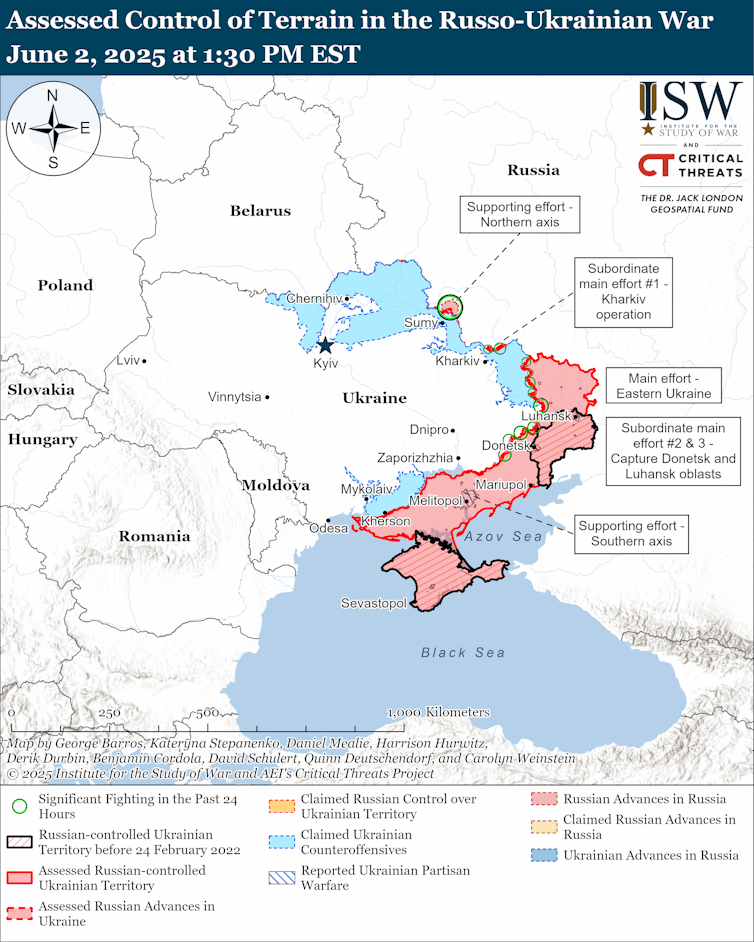News of the spectacular “spiderweb” mass drone attack on Russian air bases on June 1 will have been uppermost in the minds of delegates who assembled the following day for another round of direct talks between Russia and Ukraine in Istanbul. The attack appears to have been a triumph of Ukrainian intelligence and planning that destroyed or damaged billions of pounds’ worth of Russian aircraft stationed at bases across the country, including at locations as far away as Siberia.
Ukraine’s drone strikes, much like Russia’s intensifying air campaign, hardly signal either side’s sincere commitment to negotiations. As it turned out, little of any consequence was agreed at the brief meeting between negotiators, beyond a prisoner swap, confirming yet again that neither a ceasefire nor a peace agreement are likely anytime soon.
But the broader context of developments on the battlefield and beyond can offer important clues about the trajectory of the war in the coming months.
Get your news from actual experts, straight to your inbox. Sign up to our daily newsletter to receive all The Conversation UK’s latest coverage of news and research, from politics and business to the arts and sciences.
At an earlier meeting in Istanbul in May, Moscow and Kyiv agreed to draft and exchange detailed proposals for a settlement. The Ukrainian proposal restated the longstanding position of Kyiv and its western allies that concessions on the sovereignty and territorial integrity of the country are unacceptable.
In other words, a Russian-imposed neutrality ruling out Nato membership and limiting the size of Ukraine’s armed forces is a non-starter for Kyiv. So is any international recognition of Moscow’s illegal land-grabs since 2014, including the annexation of Crimea.
The Ukrainian proposal is for an immediate ceasefire along the frontline as “the starting point for negotiations”. Any territorial issues would be discussed “after a full and unconditional ceasefire”.
In substance, this is very similar to the peace plan presented by the Ukrainian president, Volodymyr Zelensky in late 2022. This was received warmly by Ukraine’s main western allies, but failed to get traction with the broader international community.
Russia’s proposals, meanwhile, are also mostly old news. Russia maintains its demands for full recognition of Russian territorial claims since 2014, Ukrainian neutrality.
These stringent Russian demands in return for even a temporary ceasefire are hardly any more serious negotiation positions from Ukraine’s perspective than Kyiv’s proposals are likely to be to Moscow. In fact, what the Kremlin put on the table in Istanbul is more akin to surrender terms.
Ukraine is in no mood to surrender. The spiderweb drone attack against Russia’s strategic bomber fleet is a significant boost for Ukrainian morale. But, like previous drone strikes against Moscow in June 2023, it means little in terms of signalling a sustainable Ukrainian capability that could even out Russia’s advantages in terms of manpower and equipment.

Closer to the frontlines inside Ukraine, Kyiv’s forces also struck the power grid inside Russian-occupied parts of Zaporizhzhia and Kherson regions. This may delay any Russian plans to expand its control over the two regions. But, like the latest drone strikes inside Russia, it is at best an operation that entrenches, rather than breaks the current stalemate.
There is no doubt that Ukraine remains under severe military pressure from Russia along most of the more than 1,000 mile frontline. The country is also still very vulnerable to Russian air attacks.
But while Russia might continue to make incremental gains on the battlefield, a game-changing Russian offensive or a collapse of Ukrainian defences does not appear to be on the cards.
International support
Kyiv’s position will potentially also be strengthened by a new bill in the US senate that threatens the imposition of 500% tariffs on any countries that buy Russian resources. This would primarily affect India and China.
These are the largest consumers of Russian oil and gas, and if New Delhi and Beijing decide that trade with the US is more important to them cheap imports from Russia, the move could cut Russia off from critical revenues and imports.
But, given how indecisive Donald Trump has been to date when it comes to putting any real, rather than just rhetorical, pressure on Vladimir Putin, it is not clear whether the proposed senate bill will have the desired effect. The bill has support of over 80 co-sponsors from both the Republican and Democratic caucuses, meaning the senate could overturn a presidential veto. But any delay in imposing tougher sanctions will ultimately play into Putin’s hands.
By contrast, European support for Ukraine has, if anything, increased in recent months. For example, EU leaders adopted their 17th sanctions package against Russia on May 20. A week later, Germany and Ukraine announced a new military cooperation agreement worth €5 billion (£4.2 billion).
It still falls short of what Kyiv would require for a major shift in the balance of power on the battlefield. But for now it is enough to prevent Russia from becoming militarily so dominant that Moscow’s current settlement proposals would present the only option for at least some part of Ukraine to survive as an independent state.
The war remains in a stalemate. Neither Moscow nor Kyiv appear to have the capacity to escalate their military efforts to the degree necessary that would force the other side to make substantial concessions.
Both sides are playing for time in the hope that their fortunes may change. For Ukraine, this would mean more US military support coupled with more sanctions pressure on Russia, while Europe follows through on building up its own and Ukraine’s defence capabilities.
Russia’s calculations will be different. Putin will need to keep his few remaining allies – China, Iran and North Korea – on side while trying to make a deal with Trump. This may be impossible to achieve.
In this case, the Russian dictator’s best hope might be that Trump does not impose any serious sanctions on Russia or its trade partners, let alone lean into increasing military support for Ukraine.
For both sides, a lot still hinges on Washington. The unpredictability of the Trump White House, much like the self-imposed restraint under Biden, not only makes it unlikely that the war in Ukraine moves beyond the current stalemate, it has become a major, and perhaps the decisive road block that enables both Moscow and Kyiv to dream of victory in a war that has become unwinnable.
Stefan Wolff is a past recipient of grant funding from the Natural Environment Research Council of the UK, the United States Institute of Peace, the Economic and Social Research Council of the UK, the British Academy, the NATO Science for Peace Programme, the EU Framework Programmes 6 and 7 and Horizon 2020, as well as the EU's Jean Monnet Programme. He is a Trustee and Honorary Treasurer of the Political Studies Association of the UK and a Senior Research Fellow at the Foreign Policy Centre in London.
Tetyana Malyarenko does not work for, consult, own shares in or receive funding from any company or organisation that would benefit from this article, and has disclosed no relevant affiliations beyond their academic appointment.
This article was originally published on The Conversation. Read the original article.







